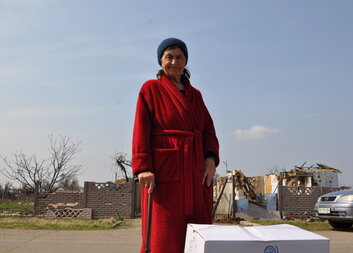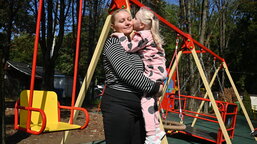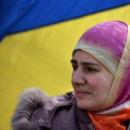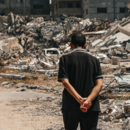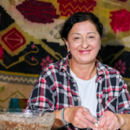For three years now, Ukraine has been facing a full-scale Russian invasion. However, the war has been ongoing since 2014, and its impacts are devastating. Millions of people have been forced to flee their homes, plunging the country into a humanitarian crisis. In addition to military operations, the conflict has profoundly affected the economy, healthcare, and infrastructure. In this article, we present seven key facts that help to understand the current situation and its impact on Ukraine and the rest of the world.
Donate to help people in Ukraine
1. When did the war in Ukraine start, and what are its roots?
The war in Ukraine began in 2014 with Russia’s annexation of Crimea. Three years ago, it escalated into a full-scale invasion of Ukraine. The conflict traces its roots back to 2013 when then-President Viktor Yanukovych refused to sign an association agreement with the European Union, sparking mass protests known as Euromaidan. Protesters demanded Yanukovych’s resignation and early elections. The consequences of Euromaidan were far-reaching.
The demonstrations culminated in February 2014 with Yanukovych’s ousting. Russia used this as a pretext to annex Crimea and support separatist movements in eastern Ukraine. Russian forces occupied the peninsula, and following a referendum that was not internationally recognised, Crimea was incorporated into Russia. The conflict then escalated in eastern Ukraine, where pro-Russian separatist groups declared independence in Donbas, leading to a prolonged war. Thousands of people lost their lives, and hundreds of thousands were forced to flee their homes. The war escalated further on 24th February 2022, when Russia launched a full-scale invasion of Ukraine, causing mass migration and extensive destruction across the country.
2. Why is this the largest armed conflict in Europe since World War II?
The invasion involves extensive military operations with large-scale troop deployments and heavy artillery. The scale of combat operations is unprecedented in the post-war era. Millions of troops have been mobilised, making the war in Ukraine the largest military conflict in Europe in the last 80 years. The intensity of the fighting, the use of modern weapons, and the involvement of various military factions from multiple countries have surpassed the conflicts in the Balkans in the 1990s. Millions of people have been displaced due to the war.
Beyond the high human toll and destruction of infrastructure, the war has also affected the global economy, influencing energy and food prices. It has had significant geopolitical consequences, impacting security in Europe and beyond. It has also reignited discussions about NATO’s role, European security architecture, and the balance of power between major global powers.
3. How many people have been displaced by the war in Ukraine?
The fighting in Ukraine has displaced nearly a third of its population, including more than half of Ukrainian children, triggering massive migration. Around 6.8 million Ukrainians have been forced to leave their country, seeking refuge in Europe and other parts of the world. Europe has witnessed its largest refugee crisis since World War II. An additional 3.7 million people have relocated within Ukraine to safer areas.
The largest number of Ukrainian refugees has been received by Poland, Germany, and the Czech Republic. A significant number have also found refuge in Canada and the United States. In terms of population proportion, Moldova has taken in the most Ukrainian refugees, followed by the Czech Republic. European countries have provided refugees with not only temporary protection but also access to employment, education, and healthcare.
Caritas Czech Republic has equipped 12 refugee centres in Moldova and has increased access to healthcare and psychosocial support. We have also supported displaced Ukrainians through direct financial assistance, which promotes long-term financial independence and helps restore dignified living conditions. We are also actively assisting those who remain displaced within Ukraine.
4. What is life like for internally displaced Ukrainians?
Millions of internally displaced Ukrainians are trying to rebuild their lives in safer parts of the country. Around 3.7 million people have chosen to stay in Ukraine despite being forced to leave their homes. Many have found refuge in safer regions, where they are striving to start again and return to a sense of normality. A significant challenge remains access to decent housing, employment, and psychological support, which are crucial for their adaptation and stability.
Caritas Czech Republic helps these people by securing shelter and supporting them in regaining independence. In western Ukraine, we have focused on renovating refugee accommodation centres and building modular homes. We also help internally displaced people secure livelihoods, enabling them to return to a more stable life as soon as possible. We offer retraining courses, support for starting businesses, and assistance in finding new job opportunities.
5. How many people in Ukraine need humanitarian aid?
Active fighting, displacement, loss of jobs, and attacks on critical infrastructure have severely limited Ukrainians’ ability to meet basic needs. Currently, around 12.7 million people in Ukraine require humanitarian aid—approximately a third of the population.
Millions of Ukrainians are facing critical conditions due to limited access to drinking water, electricity, and other necessities. Caritas Czech Republic has been providing humanitarian aid since the first days of the war. We are now primarily helping people survive the winter by distributing warm clothing, fuel, and other essentials in war-affected areas.
6. How do attacks on Ukrainian infrastructure impact civilians?
Hospitals, schools, residential areas, and other key infrastructure have become frequent targets of Russian attacks. Repeated strikes on power plants, substations, energy grids, and heating plants have disrupted energy supplies for millions of people, having a catastrophic impact on civilians, particularly in winter, exacerbating the humanitarian crisis in Ukraine. Repairing damaged infrastructure remains difficult due to ongoing fighting and limited resources.
Attacks on medical facilities have prevented access to essential healthcare and complicated the rescue of injured civilians. The number of attacks on hospitals and medical centres continues to rise, with many facilities destroyed or severely damaged. The lack of medicine, equipment, and medical staff has further worsened the health crisis in affected areas.
Under international humanitarian law, particularly the Geneva Conventions, deliberate attacks on civilian infrastructure are prohibited and may be considered war crimes. In 2023, the International Criminal Court in The Hague launched the first prosecutions of individuals accused of war crimes committed in Ukraine.
7. How is Caritas Czech Republic helping war-affected Ukraine?
Caritas Czech Republic has been active in Ukraine for many years. Initially, our efforts focused on social services, healthcare, and education, as well as supporting people affected by the conflict in eastern Ukraine.
After the Russian invasion in February 2022, we provided immediate humanitarian aid, financial support, and psychological care. Currently, we are focusing primarily on assisting internally displaced people, ensuring they have decent housing and helping them regain independence.
In Ukraine, we are able to provide assistance thanks to the support of the Czech Development Agency, UNHCR, the Ukraine Humanitarian Fund (UHF), New Dawn, ZOA Ukraine, IOM Ukraine, and other partners.
Thank you for helping with us.
Donate to help people in Ukraine

